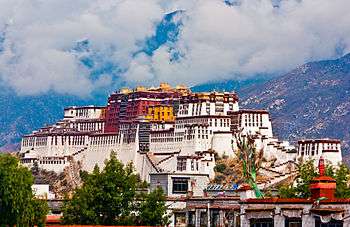Nyethang Drolma Temple
| Nyethang Drolma Temple | |
|---|---|
| Tibetan transcription(s) | |
| Tibetan | སྙེ་ཐང་སྒྲོལ་མ་ལྷ་ཁང་ |
| Wylie transliteration | snye thang sgrol ma lha khang |
| THL | Nyétang Drölma Lhakhang |
| Chinese transcription(s) | |
| Simplified | 聶塘卓瑪拉康 |
| Pinyin | Niètáng Zhuómǎ Lākāng |
 Nyethang Drolma Temple Location within the Tibet Autonomous Region, China | |
| Coordinates | 29°31′46″N 90°56′59″E / 29.529446°N 90.949693°ECoordinates: 29°31′46″N 90°56′59″E / 29.529446°N 90.949693°E |
| Monastery information | |
| Location | Nyêtang, Qüxü County, Lhasa, Tibet Autonomous Region, China |
| Founded by | Atiśa, Dromtön |
| Type | Tibetan Buddhist |
| Sect | Gelug |
The Nyethang Drolma Temple (Wylie: snye thang sgrol ma lha khang ) is a temple in Nyêtang in the Tibet Autonomous Region of China dedicated to Tara. It is associated with Atiśa (980–1054), who founded the Kadam school of Tibetan Buddhism. The monastery survived the Cultural Revolution relatively undamaged. It is dedicated to Tara, a female bodhisattva, and contains many statues and paintings of Tara.
Location
The Nyethang Drolma Temple is southwest of Lhasa on the Qüshü–Nepal Highway 36 kilometres (22 mi) from the county seat and 33 kilometres (21 mi) from Lhasa.[1] It is in Nyétang, Qüxü County.[2] It is easily accessible from Lhasa and many pilgrims visit it.[2] In 2012, the temple had 25 monks.[3] Another source states there are just seven Gelug monks.[4]
History
Atiśa taught the Four Tantras to physicians in the monastery, and later died there.[5] Some sources say that Atiśa built the monastery, which was expanded after his death by his pupil Dromtön.[2] Another version says that Dromtön raised funds to build the temple to commemorate his old friend.[1] In 1057 Dromtön brought Atisha's body from Nyethang to Reting Monastery, and placed his remains in a stupa built by an Indian artist.[6]
The monastery survived the Cultural Revolution without much damage, and was able to preserve most of its valuable artifacts, due to the intervention of Premier Zhou Enlai at the request of the government of what is now Bangladesh.[5] The main hall was rebuilt in the 1990s.[2] In March 2010, a project began to restore the southern hall, which had deteriorated in the 1980s due to poor maintenance. 900,000 yuan were allocated for the job.[7]
Description
The small two-story temple is a good example of 11th century Tibetan temple architecture.[8] The temple has a long, open porch with regularly-spaced symmetrical windows.[9] The Dalai Lama used the second floor as a residence; he often came to visit and worship.[2] This floor today has a library and some meditation rooms.[3] In the interior there are three small chapels.[8] The south hall of the temple is the Coffin Tower Hall of Atiśa. It has a floor area of 359 square metres (3,860 sq ft).[7]
The temple has many statues and paintings of Tara, a famous female bodhisattva.[2] The depictions of Tara are colored in natural pigments of white, blue, green and red.[8] In the sutra-chanting chapel, there are 21 life-size bronze statues of Tara. The main statue is of Gautama Buddha with a small statue of Atiśa to the left.[3] There is a relic from Naropa at this site as well.[9]
Hugh Edward Richardson photographed a figure of Atiśa in ceremonial dress enthroned in a shrine in one of the temples. Steps led to the throne, and there were five bowls of water offerings on the topmost one. There was a gilded roof immediately above the figure's head above which was a ceremonial umbrella.[10] Other preserved artifacts include two clay statues of the Four Heavenly Kings, a stone grinder that Yuthog Yontan Gonpo used in making medicines and stacks of old manuscripts that make up the Kangyur section of the Tibetan Buddhist canon.[5]
References
- 1 2 Nie Tong Temple, CTO.
- 1 2 3 4 5 6 Chinese Buddhist temple tour.
- 1 2 3 Buckley 2012, p. 178.
- ↑ TBRC Resource ID: G4605.
- 1 2 3 Fenton 1999, p. 93.
- ↑ Kossak & Bruce-Gardner 1998, p. 59.
- 1 2 Renovation of Drolma Lhakhang Temple to begin ... 2010.
- 1 2 3 Drolma Lhakhang Temple, Bamboo Compass.
- 1 2 Drolma Lhakhang, Tibet Guru.
- ↑ Figure of Atisha in a temple at Nyethang.
Sources
- Buckley, Michael (2012). Tibet. Bradt Travel Guides. ISBN 978-1-84162-382-5. Retrieved 2015-02-25.
- "Chinese Buddhist temple tour: Lhasa Nie Tong Temple (Dolma Lacan)" (in Chinese). 2007-10-17. Retrieved 2015-02-25.
- "Drolma Lhakhang Temple". Bamboo Compass. Retrieved 2015-02-25.
- "Drolma Lhakhang". Tibet Guru. Retrieved 2015-02-25.
- Fenton, Peter (1999-10-01). Tibetan Healing: The Modern Legacy of Medicine Buddha. Quest Books Theosophical Publishing House. ISBN 978-0-8356-0776-6.
- "Figure of Atisha in a temple at Nyethang". The Tibet Album. The Pitt Rivers Museum. 2006-12-05. Retrieved 2015-02-24.
- Kossak, Steven; Bruce-Gardner, Robert (1998-01-01). Sacred Visions: Early Paintings from Central Tibet. Metropolitan Museum of Art. ISBN 978-0-87099-862-1. Retrieved 2015-02-25.
- "Nie Tong Temple". China Tibet Online. 2005-07-04. Retrieved 2015-02-25.
- "Renovation of Drolma Lhakhang Temple to begin in March". Xinhua News Agency. 2010-02-13. Retrieved 2015-02-25.
- "TBRC Resource ID: G4605". Tibetan Buddhist Resource Center. Retrieved 2015-02-25.

